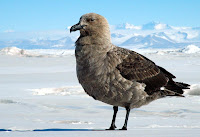 Day One: Set Up. The focal point of this research is to determine the composition of the lake water present of the four lakes in the Taylor Valley of Antarctica. To do this we take samples of lake water at various pre-determined depths below the ice. These l
Day One: Set Up. The focal point of this research is to determine the composition of the lake water present of the four lakes in the Taylor Valley of Antarctica. To do this we take samples of lake water at various pre-determined depths below the ice. These l akes are all permanently ice covered, so initially a hole was created using a Hotsi (this is hot coil of wire that is run on a generator and it melts the ice in a circular area), this was done initially several years ago, so all we had to do was reopen the hole. To do this we used a chipper bar and broke away the ice. Then we measured the ice thickness in three different holes.
akes are all permanently ice covered, so initially a hole was created using a Hotsi (this is hot coil of wire that is run on a generator and it melts the ice in a circular area), this was done initially several years ago, so all we had to do was reopen the hole. To do this we used a chipper bar and broke away the ice. Then we measured the ice thickness in three different holes.Day Two: Sampling. The sampling takes place in one day. Most of the material we are analyzing is organic and inorganic matter, bacteria, carbon, phosphate, nitrogen and other elements. However, we are also sampling for chlorophyll a (used in photosynthesis to turn light energy into usable energy or sugars for plants) and as a precaution the chlorophyll a cannot be exposed to light so much of the research must be done in semidarkness.
4:00 AM. Out of bed, into the snow gear, and down to the hut for a quick snack.
4:45 AM Head out to the lake and get ready to start the sampling.
5:00 AM Start sampling. This is a three person job, one person is in charge of pulling the samples up from the hole, another is in charge of filling the bottles with lake water, and the third puts chemicals into particular samples.
7:00 AM Some of the samples are tagged with isotopes (an isotope is a chemical that can bind in place of other compounds, but it has been radioactively modified so that it can be picked up during analysis).
8:00 AM Back at camp for breakfast (the other two people here cook for the three that are up early), then before we even sit down to eat we start filtering on 6 deepest depths.
Filtering is done using a special filter about the size of a nickel. Three different types of filtering are done, one picks up only Carbon-Nitrogen compounds or CNs, another picks up Phosphorus, and the last picks up chlorophyll, so this means all filtering is done in the dark, so as not to ruin the chlorophyll samples.Particles that are in the water are often off white, but some have color like this sample (photo left) which was taken at 25 meters below the top of liquid water (this sample took over 4 hours to filter completely).
Break for lunch, Break for dinner, samples are finished by 6-7 PM and then the day winds down. Clean up the labs, and hop in bed, grateful that everything went according to schedule.Day Three:
Finish up the tests.We also run other tests that I will go into in more detail later. But for now here is a picture of my tent (below) and the huge glacier right behind it!













 D
D












